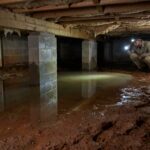Essential Guide to Foundation Repair: Protecting Your Home from Structural Damage
When it comes to the safety and longevity of your home, few things are as crucial as a solid foundation. Think of your house as a glorious cake—without that sturdy base layer, everything else can crumble into a gooey mess. Just like you wouldn’t want your cake to sag under the weight of a lavish frosting, you definitely don’t want your home to experience structural damage due to foundation issues. So, let’s dig into the essential guide to foundation repair and learn how to fortify your abode against the forces of nature (and time).
Understanding Your Foundation: The Unsung Hero of Your Home
Before we dive into repairs, let’s take a moment to appreciate what your foundation does. It’s not just a concrete slab or a stack of bricks. Your foundation supports your entire home, distributing its weight evenly and providing stability against environmental factors. This crucial structure can come in various forms, including:
1. **Basement Foundations**: These often include poured concrete or block walls that provide both shelter and structural support. They’re great for those who love to host epic game nights or need extra storage space.
2. **Crawl Space Foundations**: Elevated above ground, these allow for better airflow and easier access to plumbing and wiring—perfect for the DIY enthusiast looking to tinker.
3. **Slab Foundations**: A common choice in warmer climates, these are simply a single concrete slab poured over the ground. Easy to install and low-profile, but they don’t offer much in terms of hiding your secret stash of unsightly wires.
Common Foundation Problems: What to Look For
Much like that odd creaking sound your car makes when you drive over speed bumps, foundations give subtle hints when something’s amiss. Keep an eye out for the following tell-tale signs of foundation trouble:
– **Cracks in Walls**: Hairline cracks are usually normal, but large cracks, especially those that widen and deepen, should raise alarm bells. They’re not just whimsical decorations; they indicate shifting or settling foundation issues.
– **Uneven Floors**: If you find yourself playing a game of hopscotch in your living room because the floor feels like a bumpy road, it’s time to investigate further.
– **Doors and Windows Not Closing Properly**: If your doors are suddenly feeling rebellious or your windows refuse to open without a fight, your foundation may be moving.
– **Water Pooling Around the Foundation**: Excessive moisture can lead to significant problems, like mold, mildew, and of course, foundation deterioration. It’s like inviting a vampire into your home—once they’re in, it’s hard to get them out!
The Importance of Timely Foundation Repair
Now that we’ve identified some warning signs, let’s talk about why addressing these issues promptly is crucial. You see, ignoring foundation problems is like ignoring a toothache—what starts as a minor discomfort can quickly escalate into a massive headache (or worse). Delaying repairs can lead to:
– **Increased Repair Costs**: Like the unfortunate price of a last-minute flight, the longer you wait to fix foundation issues, the more expensive it becomes.
– **Structural Damage**: Continued settling or shifting can compromise not just your foundation but other parts of your home, including walls, ceilings, and even your roof. Suddenly, your charming abode turns into a scene from a horror movie.
– **Decreased Home Value**: No one wants to buy a fixer-upper that looks like it’s been through an earthquake. Addressing foundation problems promptly protects your investment in your home.
Assessing the Damage: When to Call a Professional
Sometimes your eyes just aren’t enough. While you could always try to channel your inner detective, there are occasions when it’s prudent to call in the experts. If you notice any major signs of foundation distress, such as extensive wall cracks or significant unevenness, bringing in a structural engineer or foundation repair specialist can save you from a world of trouble.
They’ll conduct a thorough assessment and identify the root cause of the problem. This might involve soil tests, examining drainage systems, or evaluating the overall construction of your home. Think of them as the foundation whisperers, able to decipher the silent language of your home’s structural support.
Exploring Foundation Repair Methods
Once you’ve determined that your foundation needs some TLC, it’s time to explore your repair options. Much like selecting a dish at a fancy restaurant, you have quite a few choices. Here are some common methods:
1. **Piering**: Ideal for homes with settled foundations, piering involves inserting steel piers beneath the foundation to stabilize it. These piers extend to the load-bearing strata below, ensuring that your home stands tall (and straight).
2. **Slab Jacking**: If you have a concrete slab foundation that has sunk, slab jacking can lift it back into place. This technique involves injecting a mixture of materials underneath the concrete to raise it. Essentially, it’s like giving your house a little boost—or a caffeine fix.
3. **Wall Anchors**: For bowing or leaning walls, wall anchors can help pull them back into alignment. It’s like giving your walls a supportive hug, ensuring they remain upright and stylish.
4. **Drainage Solutions**: If excess water is your nemesis, installing proper drainage systems like French drains can help redirect water away from your foundation. After all, no one likes unwanted guests—especially those who bring dampness and mold with them.
Preventative Measures: Keeping Your Foundation Healthy
Much like eating your veggies and exercising, preventing foundation damage is a proactive approach. Here are some tips to keep your foundation in tip-top shape:
– **Maintain Proper Drainage**: Ensure gutters and downspouts direct water away from your foundation. A little landscaping can also go a long way, sloping the ground away from your home.
– **Control Moisture Levels**: Consider using a dehumidifier in your crawl space or basement. Keeping humidity in check helps prevent mold growth and wood decay.
– **Inspect Regularly**: Make foundation inspections part of your home maintenance routine. Catching small issues before they become big problems is vital.
– **Watch for Trees**: While trees are fantastic for your yard, their roots can wreak havoc on your foundation if planted too close. Keep them at a safe distance to prevent any root-forging disasters.
When to DIY vs. When to Hire a Pro
You might feel tempted to roll up your sleeves and tackle foundation repairs on your own, especially after watching a few online tutorials. However, determining whether to go the DIY route or call in the cavalry can be tricky. Here’s a quick breakdown:
**DIY**: Minor cosmetic repairs like filling small cracks or touching up paint are usually safe for the intrepid home improvement warrior. Just remember, if you feel out of your depth, it’s okay to reach for the phone instead.
**Professional Help**: Complicated foundation issues require the expertise of skilled professionals. If you notice significant structural damage, it’s best not to take chances. After all, foundations are not the ideal area for trial and error.
Wrapping Up
Your home’s foundation is a critical element that demands respect and attention. By understanding the signs of foundation problems, knowing when to seek professional help, and implementing preventative measures, you can protect your humble abode from the perils of structural damage. Remember, a healthy foundation equals a happy home! As you embark on this journey to safeguard your castle, know that with a little effort and care, your foundation will stand firm against whatever life throws at it. So go forth and keep your home steady—one solid block at a time!


